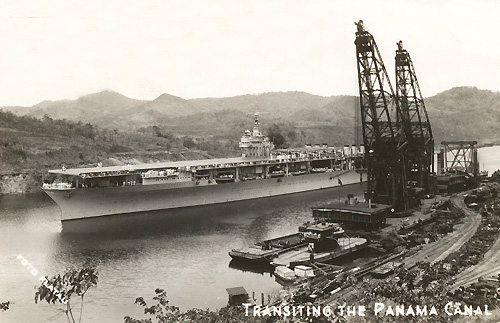 |
Photo of the Week
May 29, 2000
 |
|
What a great old photo!! I recently purchased this wonderful old "Foto Flatau" post card. Here the Dredging Division is situated on the bank of Culebra Cut at Paraiso. The aircraft carrier is the "USS Ranger (CV-4)" is in transit. I found this old photo to be a must for my collection because it has both the floating cranes "Hercules" and "Ajax" side by side. You can see one of the dipper dredges behind the cranes. But...most interesting is a ferry boat at dock in the foreground and sandwiched between a scow (barge) and the shore. This was probably part of the Thatcher Ferry Fleet. Another interesting item is all the railroad track on shore. This same area was part of a massive locomotive shop area during the construction days and these tracks could be a carry over from those days. In fact, the cross over railroad bridge that connected the East and West banks before and after the flooding was in this area. What a great piece of Canal history....(I will have some more information pertaining to the aircraft carrier in the near future....could prove very interesting) I love it when a good photo surfaces and offers so much information!! See contributor information below: Note about the USS Ranger from Andrew Fraser and Lew Taber : The Ranger (CV-4) was the first carrier designed and built as a fleet fast carrier from the keel up. Unusual features in her design were: bow arresting gear, a small island, and the smoke stacks on either side of the stern, hitch could be rotated to the horizontal position during flight landing operations. The Ranger was commissioned on 4 June 1934, survived the war and was decommissioned on 31 January 1947 and was scrapped. More info submitted by Lance Terrell (CHS 1958): I would like to comment on your Photo of the Week for 29 May 2000 (photo
number 107), showing the USS "Ranger" at the Dredging Division site at Paraiso while transiting the Canal.
Regardless of the post mark date of the mid 1940's which you have stated in the photo's caption, this photo was
actually taken on 7 April 1935, with the carrier enroute to San Diego from Norfolk. She departed Norfolk on 28 March 1935 and arrived at
San Diego on 15 April. This was her first long cruise after her
initial shakedown training cruise off the east coast of South America in 1934. Once in the
Pacific after the Canal transit, she stayed there for four years, returning to the Caribbean and the
Atlantic, via the Canal, in 1939. During World War 2, she served the majority of her time in the Atlantic, participating in the
North African invasion (Operation Torch) in November 1942, participating in raids on Norway in 1943, and performing duties as
an aircraft ferry at various times. |
Home/Back to Photo Room/Photo of the Week Archives
